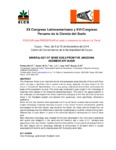Please use this identifier to cite or link to this item:
http://www.alice.cnptia.embrapa.br/alice/handle/doc/1014215Full metadata record
| DC Field | Value | Language |
|---|---|---|
| dc.contributor.author | FONTES, M. P. F. | pt_BR |
| dc.contributor.author | XAVIER, B. T. L. | pt_BR |
| dc.contributor.author | KER, J. C. | pt_BR |
| dc.contributor.author | LIMA, H. N. | pt_BR |
| dc.contributor.author | SOUZA, K. W. de | pt_BR |
| dc.date.accessioned | 2015-04-24T11:11:11Z | pt_BR |
| dc.date.available | 2015-04-24T11:11:11Z | pt_BR |
| dc.date.created | 2015-04-24 | pt_BR |
| dc.date.issued | 2014 | pt_BR |
| dc.identifier.citation | In: CONGRESO LATINOAMERICANO DE LA CIENCIA DEL SUELO, 20.; CONGRESO PERUANO DE LA CIENCIA DEL SUELO, 16., 2014, Cusco. Educar para preservar el suelo y conservar la vida en la tierra. Cusco: Centro de Convenciones de la Municipalidad del Cusco, 2014. 1 Pendrive. | pt_BR |
| dc.identifier.uri | http://www.alice.cnptia.embrapa.br/alice/handle/doc/1014215 | pt_BR |
| dc.description | ABSTRACT: The Amazonia Forest is an important biome that possesses great diversity of fauna and flora, which can play a significant role in several science areas, specially, the gene reserve for the future of humankind. Nevertheless, it is a very poorly understood environment, particularly the basis of this ecosystem, its soils. This study was conducted to gain insight in the mineralogy of important soils classes of the Amazonia sedimentary basin. The soils in the upland position in the landscape are developed from tertiary sediments belonging to the Alter do Chão series and those in the floodplain position are derived from quaternary, more specifically, Holocene´s sediments. Sand, silt and clay fractions were separated and X-ray diffraction analysis was conducted. Very simple mineralogy composed basically of quartz in the coarser fractions and kaolinite, goethite and anatase for the finer fraction was found for the Oxisol, the Ultisol and the Entisol from an upland toposequence but differences in kaolinite crystallography could be noticed among them. Gibbsite was virtually absent, in spite of the advanced degree of development of most of these soils. More distinctive mineralogy was revealed for the soils developed in the more recent sediments with quartz and feldspars in the sand and silt fractions and a suite of 2:1 minerals also appearing in their clay fraction, besides kaolinite and goethite. In one upland soil petroplinthite is the main feature and its mineralogy reflected its environment of formation which is usually associated with level to gently sloping areas with fluctuating water table. | pt_BR |
| dc.language.iso | eng | eng |
| dc.rights | openAccess | eng |
| dc.subject | Terra firme | pt_BR |
| dc.title | Mineralogy of some soils from the Amazonia Sedimentary Basin. | pt_BR |
| dc.type | Artigo em anais e proceedings | pt_BR |
| dc.date.updated | 2015-04-24T11:11:11Z | pt_BR |
| dc.subject.thesagro | Solo | pt_BR |
| dc.subject.thesagro | Solo aluvial | pt_BR |
| dc.subject.thesagro | Solo argiloso | pt_BR |
| dc.subject.thesagro | Bacia sedimentar | pt_BR |
| dc.subject.nalthesaurus | Soil | pt_BR |
| dc.subject.nalthesaurus | Alluvial soils | pt_BR |
| dc.subject.nalthesaurus | Upland soils | pt_BR |
| dc.subject.nalthesaurus | Clay minerals | pt_BR |
| dc.subject.nalthesaurus | Sedimentary soils | pt_BR |
| dc.subject.nalthesaurus | Amazonia | pt_BR |
| riaa.ainfo.id | 1014215 | pt_BR |
| riaa.ainfo.lastupdate | 2015-04-24 | pt_BR |
| dc.contributor.institution | M. P. F. FONTES, UNIVERSIDADE FEDERAL DE VIÇOSA | eng |
| dc.contributor.institution | B. T. L. XAVIER, UNIVERSIDADE FEDERAL DE PERNAMBUCO | eng |
| dc.contributor.institution | J. C. KER, UNIVERSIDADE FEDERAL DE VIÇOSA | eng |
| dc.contributor.institution | H. N. LIMA, UNIVERSIDADE FEDERAL DO AMAZONAS | eng |
| dc.contributor.institution | KLEBERSON WORSLLEY DE SOUZA, CPAC. | eng |
| Appears in Collections: | Artigo em anais de congresso (CPAC)  | |
Files in This Item:
| File | Description | Size | Format | |
|---|---|---|---|---|
| CongressoLatinoamericanoPeruanoCienciadoSolo4.pdf | 175,77 kB | Adobe PDF |  View/Open |









